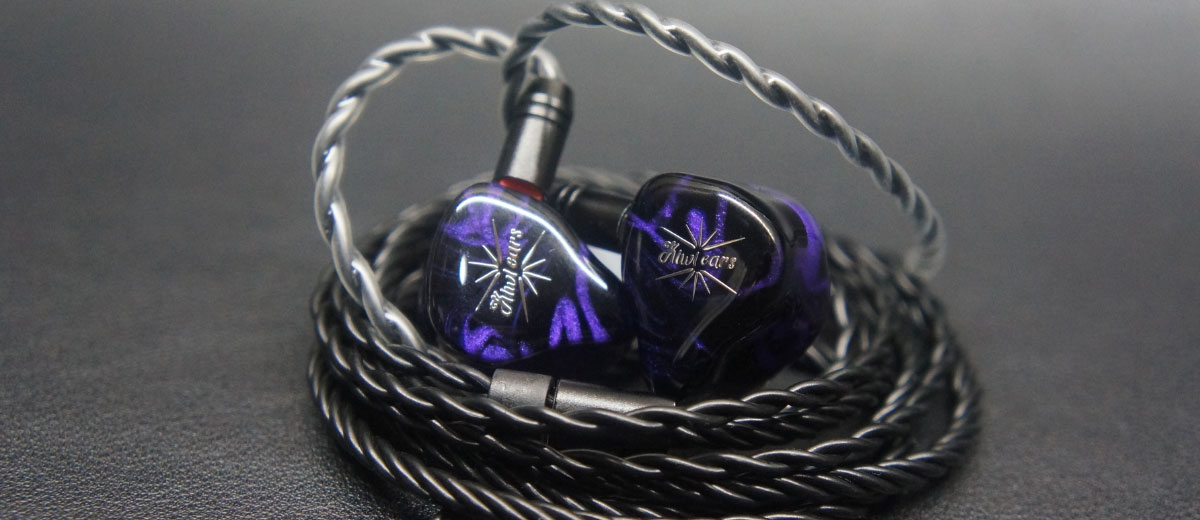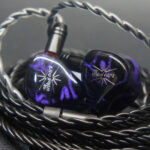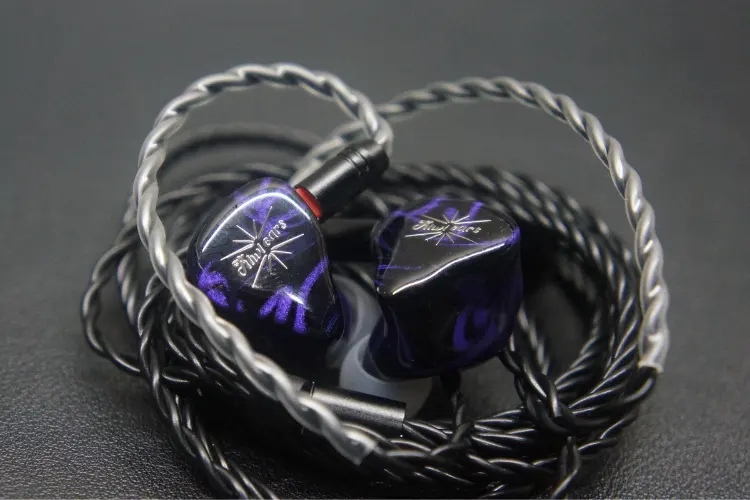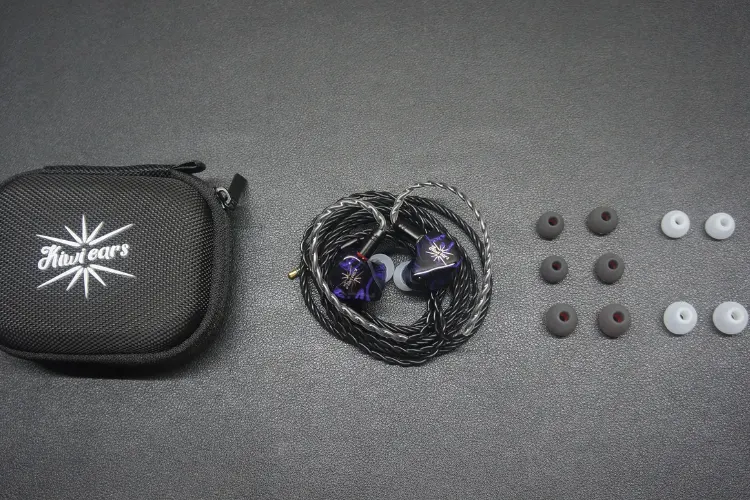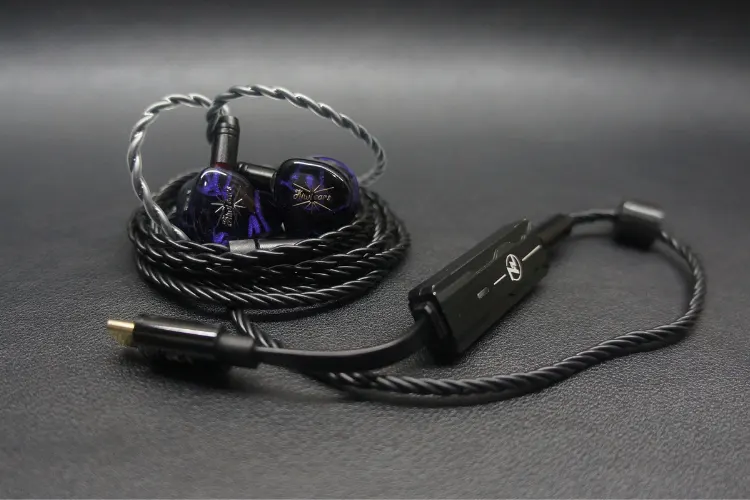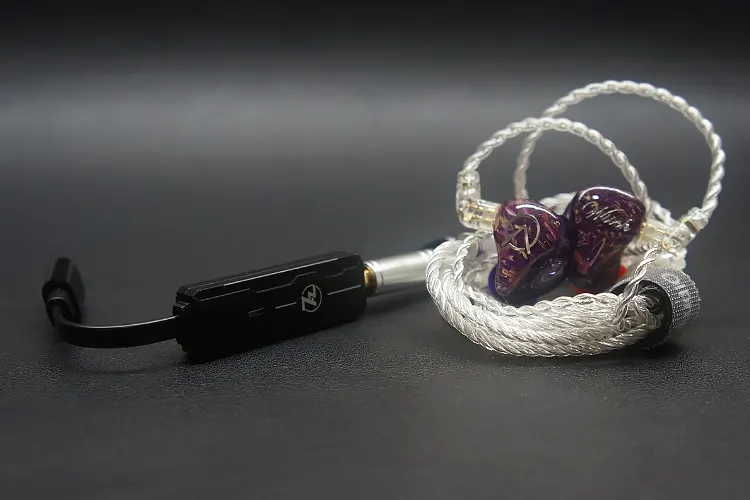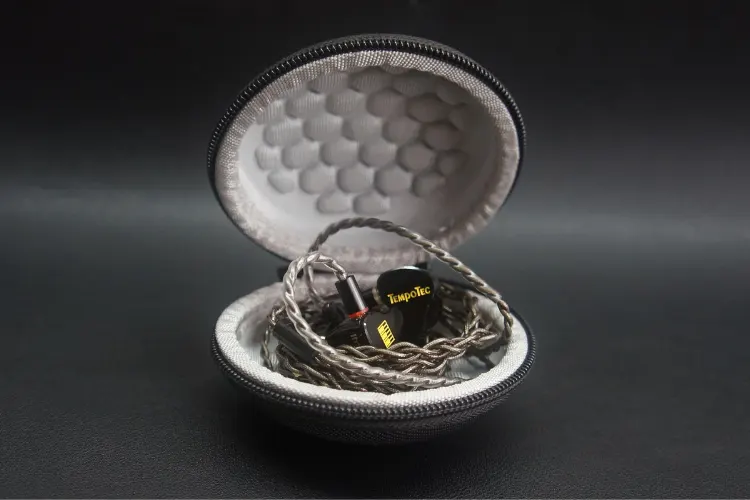We review the Kiwi Ears Quartet, which is a hybrid multi-driver universal IEM featuring dual isobaric dynamic and 2 balanced armature drivers. It is priced at $109.
Disclaimer: This is a sample sent in exchange for our honest opinion. Headfonics is an independent website with no affiliate links or services. We thank Linsoul and Kiwi Ears for their support.
To read more about Kiwi Ears gear previously covered on Headfonics please click here.
Note, this article follows our latest scoring guidelines which you can read up on here.
Kiwi Ears, the newest Chi-Fi darling that’s been slowly picking up steam after their recent Orchestra and Orchestra Lite IEMs, are now attempting to enter the hyper-competitive $150 market with their latest hybrid dual dynamic and dual BA IEM, the Quartet.
Coming with 2 tuning switches, the Quartet also lets the listener pick from 4 different tuning styles. But let’s find out if any of the tuning settings have what it takes to make a splash within the price segment.
Tech Highlights
The Quartet uses two 10mm titanium diaphragm dynamic drivers in an isobaric configuration, similar to pricier IEMs such as the Moondrop Blessing 3.
The dynamic drivers are paired with two custom-balanced armature drivers that are tuned to fit the Quartet’s sound signature, delivering crisp and clear mids and highs.
The Quartet also has two tuning switches that affect different frequency ranges. The switches can be toggled on or off with a small tool or a fingernail, allowing you to customize the sound signature according to your preference and music genre.
These two tuning switches essentially give you 4 different tuning options to cycle through depending on one’s mood and music library at any given time. Unlike other IEMs making use of the same gimmick, each tuning option is noticeably different from the others.
Design
The Quartet has a tasteful resin shell with purple and black swirls surrounding the entire shell is one piece of medical-grade resin, unlike IEMs such as the TempoTec IM05 wherein a separate metal faceplate is used.
An inlaid Kiwi Ears logo in a gold-stylized font can be seen on the outward-facing surfaces of both IEMs. Two switches can be seen towards the rear of the IEM shell, labeled “1” and “2” respectively.
The switches are quite difficult to operate even with long fingernails, so the use of a tool such as the SIM-removal tool that comes with most smartphones is recommended.
The one-piece resin construction gives it very good build quality, without any visible seams when running my fingernail throughout the IEM shell. The resin material used holds up well in day-to-day use, doing a good job of not showing fingerprints and micro scratches.
The top of the shell comes with a standard 2-pin 0.78mm port that lies flush with the whole shell. Giving the IEMs an unobstructed silhouette even when the cables aren’t attached to the IEMs themselves.
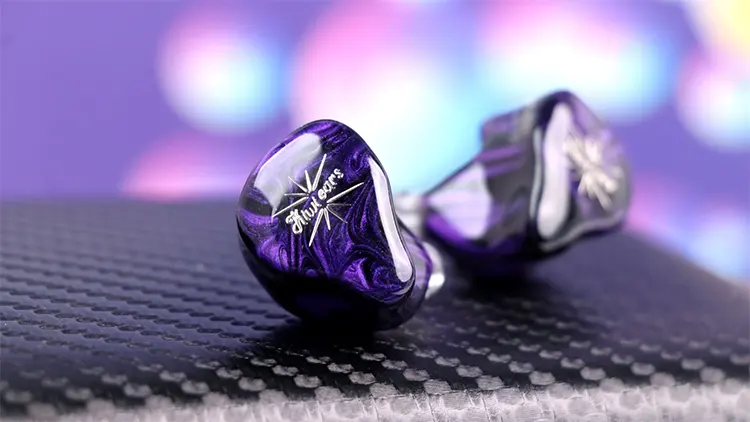
Comfort & Isolation
The Quartet has a smooth and ergonomic shell design that fits comfortably in my ears without any sharp edges or pressure points. It is slightly larger than the Open Audio Witch Pro, an IEM that also makes use of a unibody resin design, but it is almost as comfortable.
The shell is made of medical-grade resin that is lightweight and durable. The ear tips are soft and snug, creating a good seal and isolation.
The IEM shell contains a minuscule vent, the site of a needlepoint, however, I’m not quite sure if this is a vent or just a remnant of the manufacturing process.
Regardless, the isolation is above average for an IEM of this type, blocking out most of the ambient noise and even medium-volume conversations. In fact, the Quartets are the best-isolating IEMs I’ve tried thus far.
The comfort is also excellent, as I can wear the Quartet for hours without any fatigue or discomfort. Despite them being on the large side, they are significantly more comfortable than IEMs like the Tempotec IM05 or the Tangzu Wu ZeTian.
Stock Cable
The Quartet comes with a detachable cable that uses a standard 0.78mm 2-pin connector. The cable is made of high-quality oxygen-free silver-plated copper wire, which is lightweight and flexible.
The cable has a black rubber coating and a black metal Y-splitter, chin slider, and 3.5mm plug. It also has pre-formed ear hooks that help secure the IEMs in place. The cable is tangle-resistant and microphonic-free, providing a noise-free audio transmission.
The cable also matches well with the two-tone black and purple shells of the IEMs, creating a cohesive and attractive look.
Packaging & Accessories
The Quartet comes in a stunning box with a purple and black sleeve reminiscent of the actual IEM shells themselves. Removing the sleeve shows a simple black cardboard box that has the Kiwi Ears logo on it.
Inside the box, you will find the IEMs in a foam cutout, along with nine pairs of silicone ear tips, (three sizes of black and three sizes of white, three sizes of gray).
The case is sturdy and has a cloth wrapping, letting it hold up well in day-to-day use. It is spacious enough to fit the IEMs, cable, and even a dongle DAC comfortably. The accessories are of good quality and provide enough options for different ear sizes and shapes.
Sound Impressions
Since one of the Quartet’s main selling points is the total of 4 different tuning modes that one could cycle through, I will be summarizing the bass, mids, and treble performance of each setting.
Please note that for the comparison portion of this review, I will only be listening to the Quartet in its stock “UP-UP” configuration.
UP/UP Configuration
The default UP-UP configuration (indicating that both turning dip switches are in the up position) has a V-shaped tuning that leans towards the warmer end.
The mid-bass is also elevated, adding some warmth and body to the lower mids, especially in deep male vocals. However, the bass can also sound a bit bloated and muddy at times, especially on bass-heavy tracks. The mids are recessed and smooth, with decent clarity and detail.
This is something worth noting since even in tuning profiles where the mids are placed further back, its mids are still more detailed than other more neutral options in the price range. The vocals are slightly veiled and distant, but still natural and pleasant.
The treble is rolled off and smooth, with no harshness or sibilance. The treble lacks some sparkle and airiness, but it also avoids any fatigue or irritation. This setting is suitable for those who like a warm and relaxed sound signature, or for genres like pop, hip-hop, EDM, etc.
DOWN/UP Configuration
This setting reduces the sub to mid-bass region, adding some brightness and energy to the sound signature, giving it a V-shaped response that leans more towards the brighter end.
The bass is still boosted, but less so than the previous setting. The bass is more controlled and textured, with less bloat and more definition. The mids appear clearer, with better separation, whilst maintaining the same detail level, however, male vocals have less body in this setting.
Female vocals in particular are more present and expressive than the default setting. The treble is more extended and crisper, with more sparkle and airiness. The treble also has some peaks and dips that can enhance some tracks or make others sound harsh or thin.
This setting is suitable for those who like a lively sound signature and listens to music that has a high amount of energy on both sides of the frequency response such as rock, metal, jazz, etc.
UP/DOWN Configuration
This setting is actually very similar to that of the UP/UP configuration but with a slightly tamer treble response giving it a more relaxing warm sound signature with strong impact and slam in the mid-bass region and sub-bass region.
This added warmth gave additional exaggeration to bass riffs and deep male vocals, but it did come at the cost of overall resolution. Amongst all four tuning settings, this was the least detailed but also the most laid-back sounding.
The bass can also sound very overpowering and boomy at times, especially on bass-heavy tracks. The mids are very recessed and smooth, with low clarity and detail. The vocals are more veiled and distant but have a natural presentation to them.
The treble is rolled off and smooth, with no harshness or sibilance. The treble lacks some sparkle and airiness, but it also avoids any fatigue or irritation.
This setting is suitable for those who like a very bassy and fun sound signature or for genres like R&B, reggae, G-Funk and etc.
DOWN/DOWN Configuration
This setting boosts both bass and treble regions to similar degrees, making them sound like a more balanced V-shape signature, whilst also improving the mid-region a bit more.
This adds some contrast and excitement to the sound signature, making it more energetic. The bass is very boosted, with solid impact and slam in the sub-bass region. The mid-bass is also very elevated, adding some warmth and fullness to the lower mids.
The mids are still recessed, but more present than the other settings, with similar separation and detail. The vocals are slightly veiled and distant, but still natural and pleasant. The treble is extended and crisp, with more sparkle and airiness.
The treble also has some peaks and dips that can enhance some tracks or make others sound harsh or thin. This setting is suitable for those who like a V-shaped and energetic sound signature, or for genres like electronic, dance, metalcore, etc.
Imaging
The Quartet has a moderate soundstage, with average width and depth. The imaging is decent, with good directionality and positioning of the instruments. The layering is fair, with some distinction between the foreground and background elements, however, the staging performance is quite sub-par.
Synergy
The Quartet has a low impedance of 32Ω and a high sensitivity of 110dB SPL/mW, making it easy to drive from most sources. However, it also benefits from additional amplification from something as simple as a 7hz SEVENHERTZ 71 dongle DAC.
I find that it doesn’t pair perfectly with the 71, I would prefer a more neutral-sounding source since one of the unit’s highlights is its multiple tuning options.
Additionally, the inherent bass boost of all tuning settings means that the bass boost of the 71 dongles isn’t quite necessary. However, it does not interfere too much with the overall tonality of the IEMs.
Select Comparisons
Open Audio Witch Pro
Technical
The Quartet uses dual 10mm DD and dual balanced armature drivers with an impedance of 32Ω and a sensitivity of 110 dB, whilst the Open Audio Witch Pro uses a hybrid mix with a single dynamic driver and balanced armature driver on each side.
They have an impedance of 20Ω, and a sensitivity of 110dB making them easier to drive. The Quartet uses the standard 0.78mm 2-pin connectors whilst the Witch Pro makes use of a shrouded QDC-style cable connector of 0.78mm 2-pin.
Design
The Witch Pros have transparent purple resin 3D-printed shells with hand-crafted glossy purple face covers, whilst the Quartet also makes use of a resin shell with a swirled black and purple design.
The Witch Pro fits slightly better in the ear due to their smaller size and is lighter as well making it slightly more comfortable all around and perfect for all-day listening. However, this does not mean that the Quartet is uncomfortable by any means, the Witch Pro is simply superior in terms of comfort.
Performance
Both have a V-shaped tuning philosophy; however, the quartet performs sonically better in almost every way.
Specifically in the default UP/UP setting, the bass on the Quartet hits harder and is better textured as well. The Quartet can hit lower notes whilst also delivering them with a more pleasing tonality.
The Quartet has a warner tonality, making it sound more pleasing and natural. Despite this, both the witch pro and the Quartet have quite similar levels of detail retrieval. This was quite surprising since warmer tonalities usually come at the expense of detail retrieval.
The mids on the quartet have more body to them and sound more satisfying, but since both IEMs are V shape, the mid-performance on the superior quartet was still a bit distant sounding. Vocals had a pleasing tonality, but they were not class-leading by any means, especially in resolution and nuance playback.
The highs on the Quartet are a bit more refined and less sibilant, whilst maintaining the same level of detail retrieval as the Witch Pro once again. This trend illustrates that the Quartet sounds like a more pleasing and warmer Witch Pro, that doesn’t sacrifice detail retrieval at all whilst being close in terms of comfort and isolation.
TempoTec IM05
Technical
The Quartet uses dual 10mm DD and dual balanced armature drivers with an impedance of 32Ω and a sensitivity of 110 dB, whilst the TempoTec IM05 uses a single 8mm dynamic driver and four balanced armature drivers.
They have an impedance of 33Ω and a sensitivity of 99dB @1kHz, making the quartets easier to drive in comparison. Both IEMs make use of the standard 2-pin 0.78mm connector and both cables terminate to a 3.5 SE jack.
Design
The IM05 makes use of a shell that seems to be constructed from 3D-printed resin with a brushed black metal faceplate with a stylized yellow piano or TempoTec logo, whilst the Quartet makes use of a resin shell with a swirled black and purple design. Unlike the IM05, the quartet does not make use of separate pieces for the faceplate and IEM shell.
The Quartet is smaller than the IM05 and fits significantly better in the ear. This, as well as the Quartet’s lighter build, makes it substantially more comfortable in day-to-day use. The IM05 isn’t uncomfortable, but the witch pro and the Quartet are just simply a class above it.
Performance
Both the IM05 and the Quartet trade blows when it comes to performance. In terms of Bass quantity, the Quartet can deliver deeper, more satisfying bass with a much more organic-sounding tonality. However, the IM05 delivers bass with more restraint and can do so while also playing back better bass texture and nuance.
The mids are another story as well. Since both IEMs are quite V-shaped, mids performance was never truly a strong suit, but the same trend follows.
The IM05 delivers class-leading detail, even though the tonality, especially in the mids, leaves something to be desired. The more satisfying and lush-sounding mids of the Quartet are more pleasing to listen to, but the mids are more resolving and evident with the IM05.
The IM05 handily beat the Quartet in the treble department. The IM05 can deliver substantially better detail retrieval, whilst not being sibilant at all. The Quartet does sound less fatiguing in comparison, but the treble performance of the IM05 was never fatiguing in the first place.
Additionally, the IM05 has better staging performance than the IM05, especially in terms of horizontal with. Instruments have better 360-degree staging with the IM05, highlighting the Quartet’s struggle to place instruments to the right and left of the listener.
Our Verdict
The Kiwi Ears Quartet is a hybrid in-ear monitor that offers a versatile and engaging sound signature that can be customized with 4 different tuning options. All in a sleek and elegant design that remains comfortable even when used all day.
It is not perfect; some listeners may view the bass to be over-present mid-bass and may believe that it executes the V-shaped sound signature too intensely. However, it also has some strengths, such as the impactful bass, the clear vocals, and the crisp treble.
This is a fun and enjoyable IEM that can cater to different tastes and moods. It is not for audiophiles who seek accuracy, neutrality, or detail retrieval.
What this set excels at is offering a pleasing energetic tonality at an affordable price, whilst giving new audiophiles the additional value of trying the tuning profile that works best for them.
Kiwi Ears Quartet Specifications
- Driver Type: 2 DD + 2BA Hybrid Driver
- Plug: 3.5mm single-ended standard 0.78mm-2pin
- Frequency Response: 20Hz -20kHz
- Impedance: 32Ω
- Sensitivity: 110 dB @1kHz

